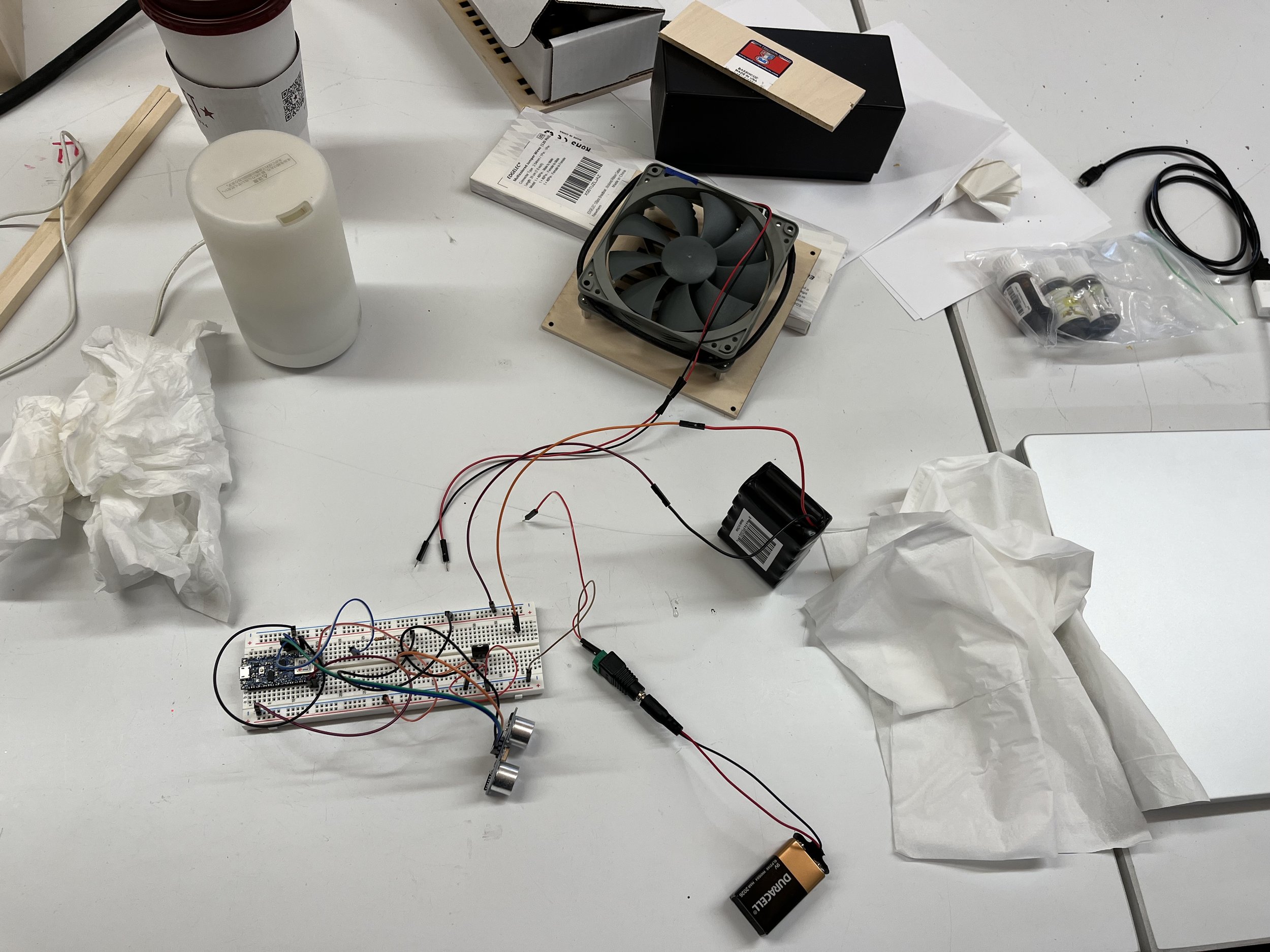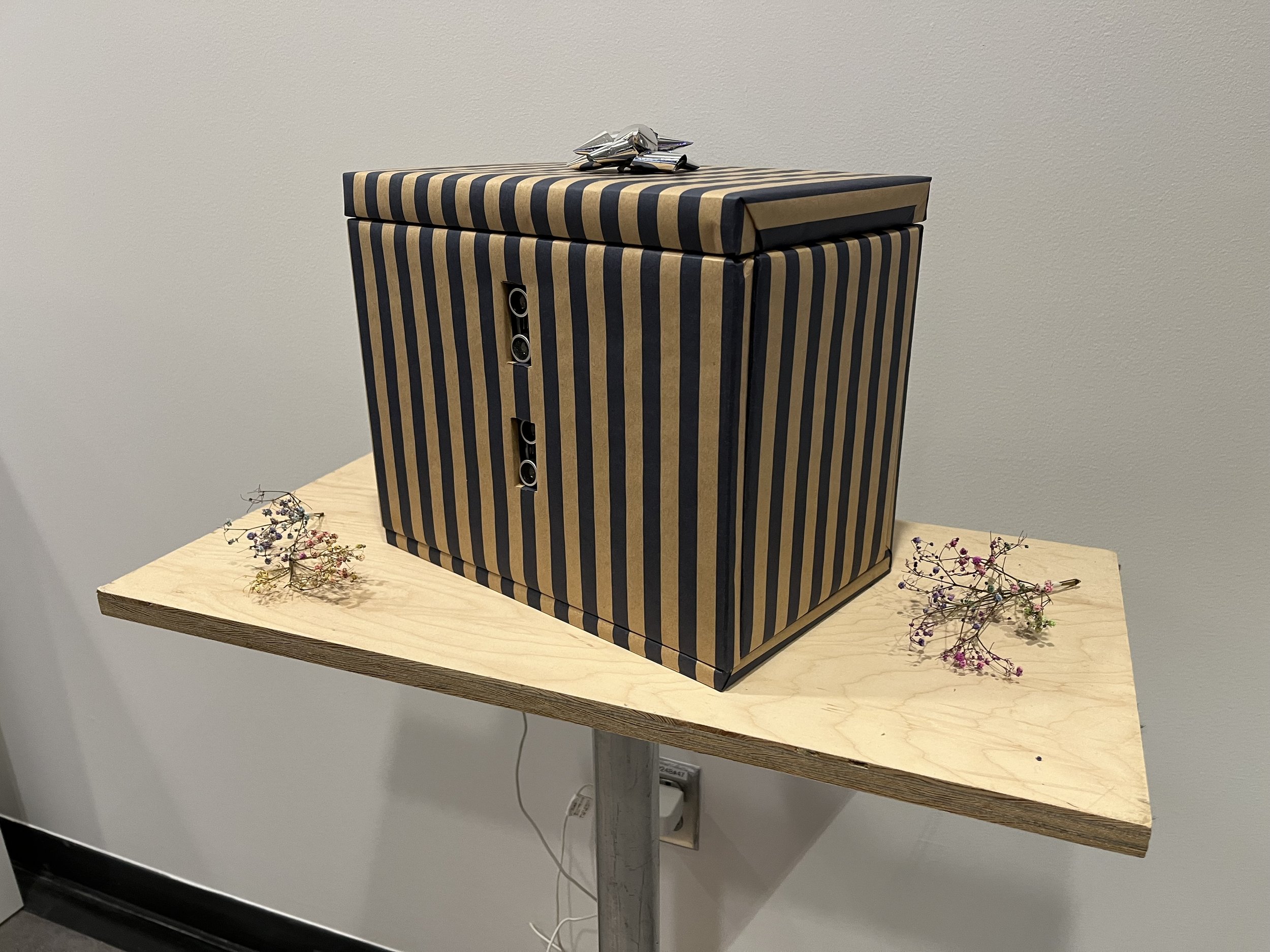Autumn Wind
Ultrasonic Distance Sensor + Aroma Diffuser
Fall 2022
Course: Physical Computing
Instructor: Tom Igoe
Partner: Nakyung Youn
Introduction + Implementation
Instead of pursuing a Halloween-themed project, we opted for a more poetic approach, creating something that evokes memories of fall for users. Smell, being the first sense we develop, holds a profound connection to our memories. Whether it's the scent of spring afternoons, summer nights, fall and winter mornings, each season carries a unique fragrance associated with specific moments. Our initial idea was to explore the interplay of wind and scent. While we couldn't design our own scent machine, we incorporated a Muji diffuser into our project. Our focus was on controlling a fan to spin and disperse the scent from the diffuser, creating a sensory experience that combines scent and wind.
To control the fan, we employed an ultrasonic distance sensor. A transistor was connected to the sensor, enabling power control. When a user is within a certain range, the fan starts spinning at half of its maximum speed. As the user gets closer, the fan accelerates to top speed, allowing them to feel the wind while experiencing the scent. Additionally, we integrated an LED light to provide a welcoming glow when users approach.
Given the time constraints, our strategy involved addressing technical challenges first and then proceeding with the assembly. Since we had two sensors that worked individually, instead of investing more time in figuring out how to make both work with one Arduino, we used two breadboards and two batteries. This approach proved to be the most efficient way to solve technical issues and focus on other aspects of the project. Our guiding principle was to make it work initially and then consider upgrades if time allowed. Ultimately, we successfully completed the project on time, employing a collaborative approach that minimized time wastage.
The items utilized in this project include:
2 breadboards, 1 Arduino Nano 33 Iot, 1 Arduino Nano 33 BLE Sense, a bunch of jump wires, 2 ultrasonic distance sensors, 2 9v batteries
1 Muji Ultrasonic Aroma Diffuser, 1 computer fan - 3-pin 1300 RPM, 1 battery pack - 12V
A basswood box, which is the container of the diffuser, a basswood stand for the breadboards, a foam core box and some gift wraps
figure 1
figure 2
figure 3
figure 4
figure 5
figure 6
The most challenging aspect, for both of us, was navigating the intricacies of the code. Although both codes could run most of the time, they didn't consistently meet our expectations. We found ourselves repeatedly checking and refining the code to achieve the desired outcomes. Occasionally, loose connections posed challenges, and while somewhat frustrating, we recognized that it was within our control. Given more time, we would have enhanced the presentation of both breadboards, possibly incorporating soldering for a neater finish. Despite these challenges, the assembly process was enjoyable. We took pride in creating a final product that is aesthetically pleasing and clean. The appearance of our gift box has left both of us quite satisfied.
figure 9
figure 10
figure 11
figure 12
video 1
video 2
Conclusion
I personally would like to explore the scent-related theme further in my upcoming projects at ITP. I am particularly intrigued by how different scents can evoke various moods for users. This project serves as an excellent foundation for such explorations. As highlighted during the review, the placement of the project's height significantly influences its presentation. Considering how others would approach and interact with the box is crucial. There are three aspects that we would have liked to address with more time:
Power for the Diffuser: We have already placed three batteries in the box to maximize mobility and independence. However, integrating the power for the diffuser into the design would make it even more portable and tidy.
Breadboards and Sensors: Combining the two breadboards into one and exploring the capability of one Arduino to control multiple sensors would streamline the design for future projects.
Moisture Management: The diffuser generates more moisture than anticipated, posing a challenge for the basswood box. If the fan stops for an extended period, moisture accumulates and can potentially affect the box and the fan's circuit. Research will be conducted to address this critical issue.
I express my sincere appreciation for the valuable suggestions, assistance, and critiques provided by Professor Tom Igoe, my classmates, and friends at ITP. Special thanks go to my partner, who worked patiently and collaboratively with me to navigate through the challenges over the past few weeks.










